Reflective Journal: Wound Dressing Experience and Skill Development
VerifiedAdded on 2022/10/12
|5
|1069
|5
Journal and Reflective Writing
AI Summary
This reflective assignment details a student's experience with wound dressing in a healthcare setting, specifically focusing on caring for a patient with a sacral pressure sore. The student, accompanied by a registered nurse, observed and participated in wound dressing procedures, noting the differences between home practices and clinical protocols. The assignment highlights the importance of hygiene, documentation, and patient education. The student reflects on the development of skills, increased confidence, and the application of aseptic techniques. The analysis includes references to relevant literature on wound dressing and the impact of available resources. The student identifies areas for future development and expresses a commitment to continuous learning and skill enhancement in wound care. The assignment is a reflection based on Gibb's Reflective Cycle as per the assignment brief.
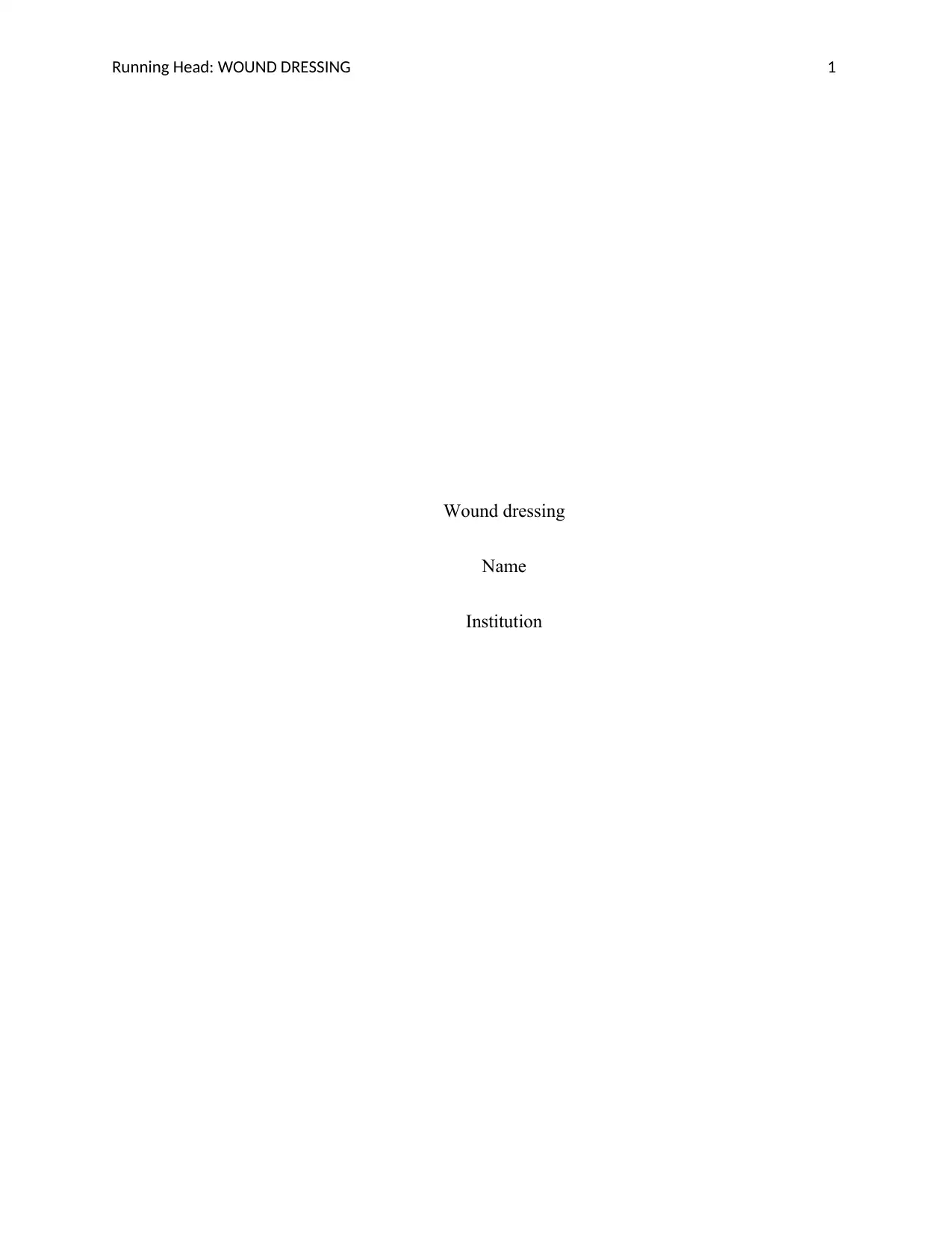
Running Head: WOUND DRESSING 1
Wound dressing
Name
Institution
Wound dressing
Name
Institution
Paraphrase This Document
Need a fresh take? Get an instant paraphrase of this document with our AI Paraphraser
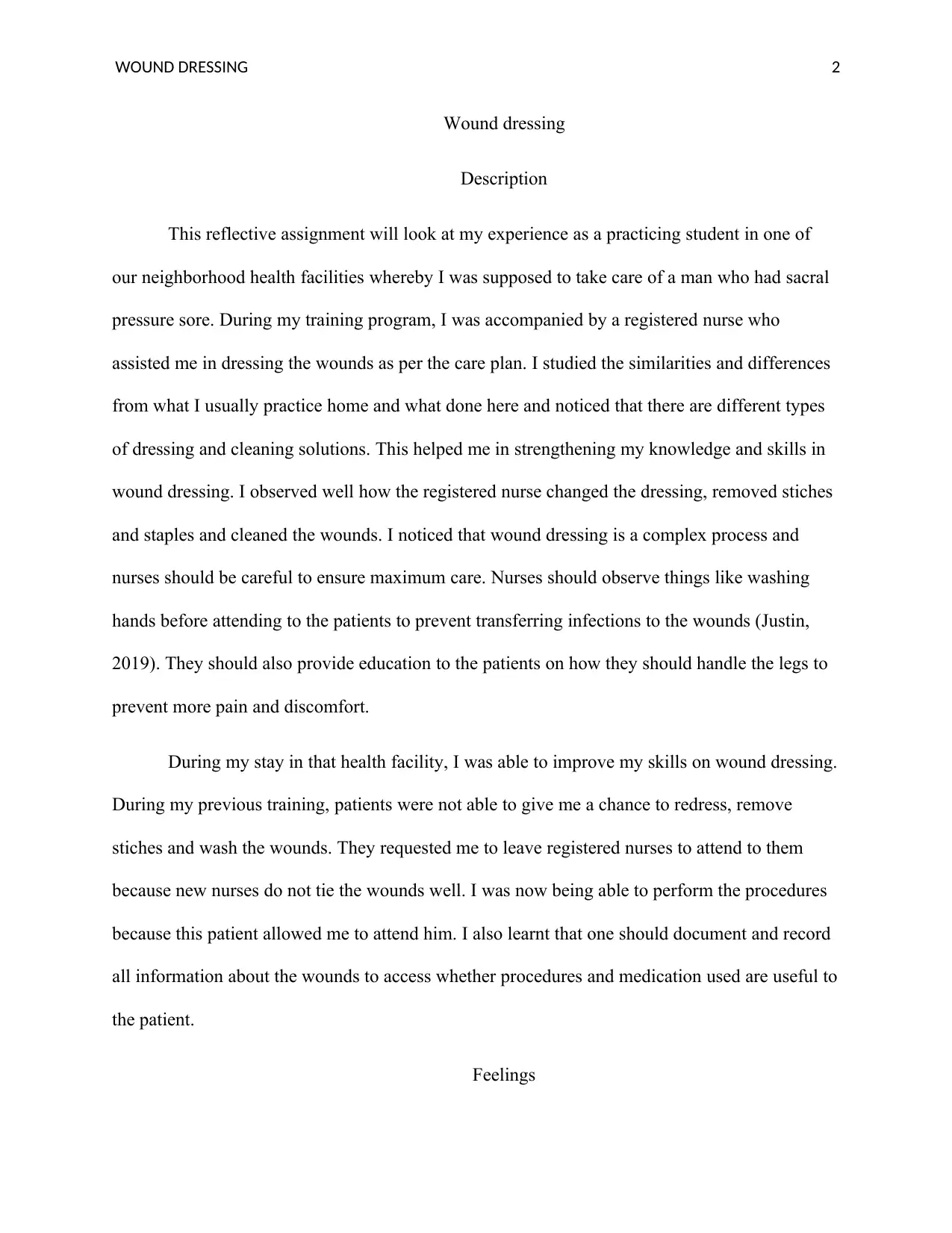
WOUND DRESSING 2
Wound dressing
Description
This reflective assignment will look at my experience as a practicing student in one of
our neighborhood health facilities whereby I was supposed to take care of a man who had sacral
pressure sore. During my training program, I was accompanied by a registered nurse who
assisted me in dressing the wounds as per the care plan. I studied the similarities and differences
from what I usually practice home and what done here and noticed that there are different types
of dressing and cleaning solutions. This helped me in strengthening my knowledge and skills in
wound dressing. I observed well how the registered nurse changed the dressing, removed stiches
and staples and cleaned the wounds. I noticed that wound dressing is a complex process and
nurses should be careful to ensure maximum care. Nurses should observe things like washing
hands before attending to the patients to prevent transferring infections to the wounds (Justin,
2019). They should also provide education to the patients on how they should handle the legs to
prevent more pain and discomfort.
During my stay in that health facility, I was able to improve my skills on wound dressing.
During my previous training, patients were not able to give me a chance to redress, remove
stiches and wash the wounds. They requested me to leave registered nurses to attend to them
because new nurses do not tie the wounds well. I was now being able to perform the procedures
because this patient allowed me to attend him. I also learnt that one should document and record
all information about the wounds to access whether procedures and medication used are useful to
the patient.
Feelings
Wound dressing
Description
This reflective assignment will look at my experience as a practicing student in one of
our neighborhood health facilities whereby I was supposed to take care of a man who had sacral
pressure sore. During my training program, I was accompanied by a registered nurse who
assisted me in dressing the wounds as per the care plan. I studied the similarities and differences
from what I usually practice home and what done here and noticed that there are different types
of dressing and cleaning solutions. This helped me in strengthening my knowledge and skills in
wound dressing. I observed well how the registered nurse changed the dressing, removed stiches
and staples and cleaned the wounds. I noticed that wound dressing is a complex process and
nurses should be careful to ensure maximum care. Nurses should observe things like washing
hands before attending to the patients to prevent transferring infections to the wounds (Justin,
2019). They should also provide education to the patients on how they should handle the legs to
prevent more pain and discomfort.
During my stay in that health facility, I was able to improve my skills on wound dressing.
During my previous training, patients were not able to give me a chance to redress, remove
stiches and wash the wounds. They requested me to leave registered nurses to attend to them
because new nurses do not tie the wounds well. I was now being able to perform the procedures
because this patient allowed me to attend him. I also learnt that one should document and record
all information about the wounds to access whether procedures and medication used are useful to
the patient.
Feelings
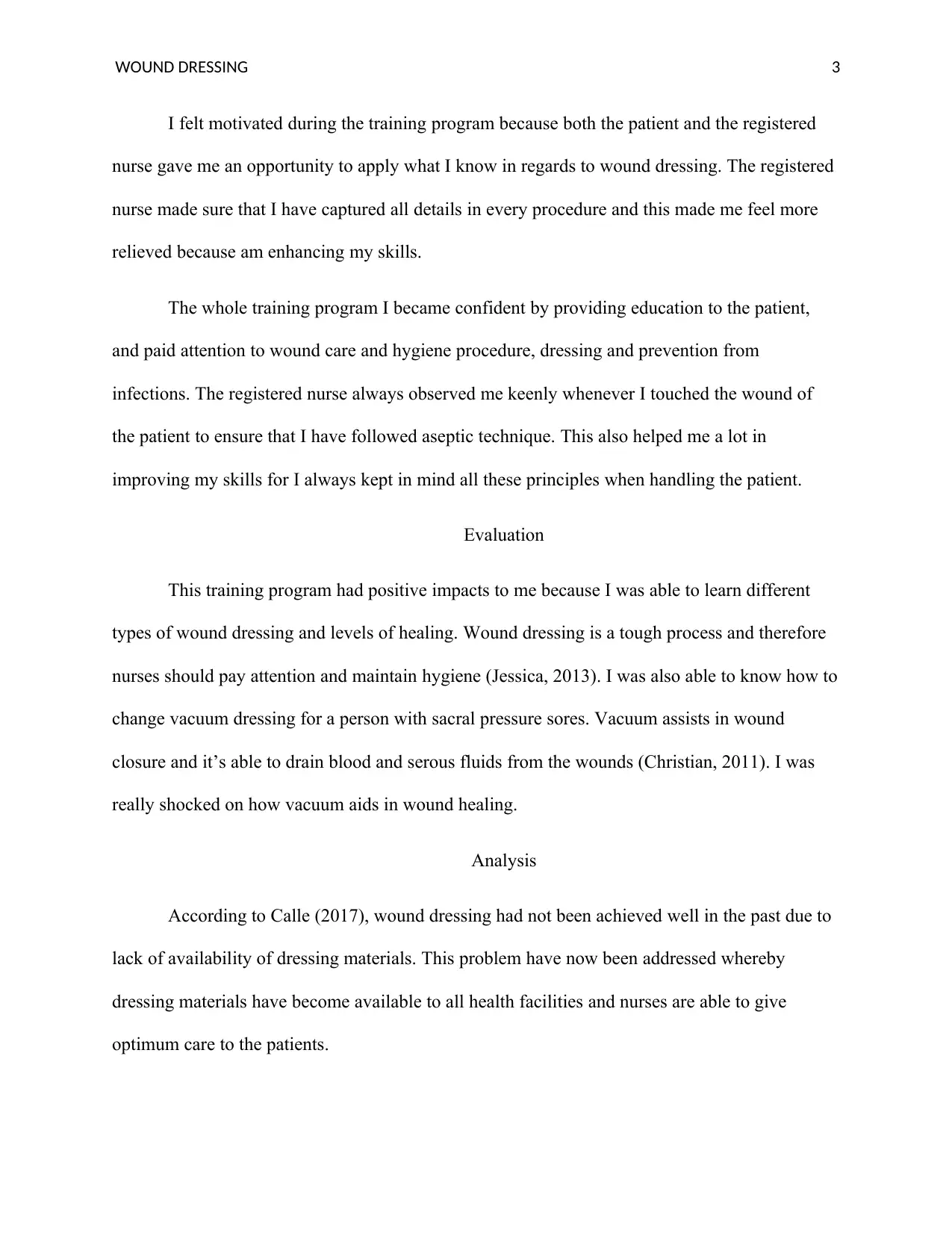
WOUND DRESSING 3
I felt motivated during the training program because both the patient and the registered
nurse gave me an opportunity to apply what I know in regards to wound dressing. The registered
nurse made sure that I have captured all details in every procedure and this made me feel more
relieved because am enhancing my skills.
The whole training program I became confident by providing education to the patient,
and paid attention to wound care and hygiene procedure, dressing and prevention from
infections. The registered nurse always observed me keenly whenever I touched the wound of
the patient to ensure that I have followed aseptic technique. This also helped me a lot in
improving my skills for I always kept in mind all these principles when handling the patient.
Evaluation
This training program had positive impacts to me because I was able to learn different
types of wound dressing and levels of healing. Wound dressing is a tough process and therefore
nurses should pay attention and maintain hygiene (Jessica, 2013). I was also able to know how to
change vacuum dressing for a person with sacral pressure sores. Vacuum assists in wound
closure and it’s able to drain blood and serous fluids from the wounds (Christian, 2011). I was
really shocked on how vacuum aids in wound healing.
Analysis
According to Calle (2017), wound dressing had not been achieved well in the past due to
lack of availability of dressing materials. This problem have now been addressed whereby
dressing materials have become available to all health facilities and nurses are able to give
optimum care to the patients.
I felt motivated during the training program because both the patient and the registered
nurse gave me an opportunity to apply what I know in regards to wound dressing. The registered
nurse made sure that I have captured all details in every procedure and this made me feel more
relieved because am enhancing my skills.
The whole training program I became confident by providing education to the patient,
and paid attention to wound care and hygiene procedure, dressing and prevention from
infections. The registered nurse always observed me keenly whenever I touched the wound of
the patient to ensure that I have followed aseptic technique. This also helped me a lot in
improving my skills for I always kept in mind all these principles when handling the patient.
Evaluation
This training program had positive impacts to me because I was able to learn different
types of wound dressing and levels of healing. Wound dressing is a tough process and therefore
nurses should pay attention and maintain hygiene (Jessica, 2013). I was also able to know how to
change vacuum dressing for a person with sacral pressure sores. Vacuum assists in wound
closure and it’s able to drain blood and serous fluids from the wounds (Christian, 2011). I was
really shocked on how vacuum aids in wound healing.
Analysis
According to Calle (2017), wound dressing had not been achieved well in the past due to
lack of availability of dressing materials. This problem have now been addressed whereby
dressing materials have become available to all health facilities and nurses are able to give
optimum care to the patients.
⊘ This is a preview!⊘
Do you want full access?
Subscribe today to unlock all pages.

Trusted by 1+ million students worldwide
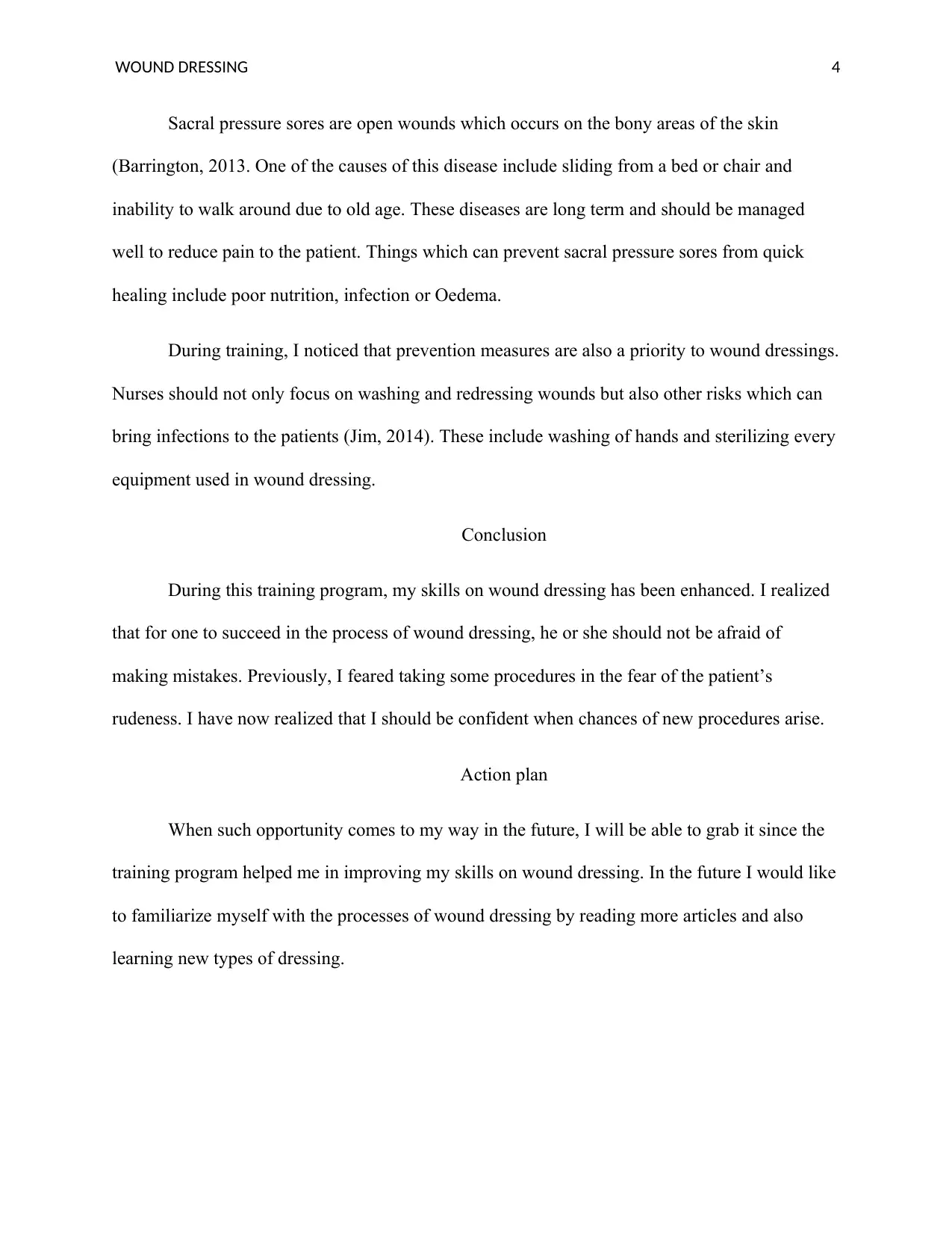
WOUND DRESSING 4
Sacral pressure sores are open wounds which occurs on the bony areas of the skin
(Barrington, 2013. One of the causes of this disease include sliding from a bed or chair and
inability to walk around due to old age. These diseases are long term and should be managed
well to reduce pain to the patient. Things which can prevent sacral pressure sores from quick
healing include poor nutrition, infection or Oedema.
During training, I noticed that prevention measures are also a priority to wound dressings.
Nurses should not only focus on washing and redressing wounds but also other risks which can
bring infections to the patients (Jim, 2014). These include washing of hands and sterilizing every
equipment used in wound dressing.
Conclusion
During this training program, my skills on wound dressing has been enhanced. I realized
that for one to succeed in the process of wound dressing, he or she should not be afraid of
making mistakes. Previously, I feared taking some procedures in the fear of the patient’s
rudeness. I have now realized that I should be confident when chances of new procedures arise.
Action plan
When such opportunity comes to my way in the future, I will be able to grab it since the
training program helped me in improving my skills on wound dressing. In the future I would like
to familiarize myself with the processes of wound dressing by reading more articles and also
learning new types of dressing.
Sacral pressure sores are open wounds which occurs on the bony areas of the skin
(Barrington, 2013. One of the causes of this disease include sliding from a bed or chair and
inability to walk around due to old age. These diseases are long term and should be managed
well to reduce pain to the patient. Things which can prevent sacral pressure sores from quick
healing include poor nutrition, infection or Oedema.
During training, I noticed that prevention measures are also a priority to wound dressings.
Nurses should not only focus on washing and redressing wounds but also other risks which can
bring infections to the patients (Jim, 2014). These include washing of hands and sterilizing every
equipment used in wound dressing.
Conclusion
During this training program, my skills on wound dressing has been enhanced. I realized
that for one to succeed in the process of wound dressing, he or she should not be afraid of
making mistakes. Previously, I feared taking some procedures in the fear of the patient’s
rudeness. I have now realized that I should be confident when chances of new procedures arise.
Action plan
When such opportunity comes to my way in the future, I will be able to grab it since the
training program helped me in improving my skills on wound dressing. In the future I would like
to familiarize myself with the processes of wound dressing by reading more articles and also
learning new types of dressing.
Paraphrase This Document
Need a fresh take? Get an instant paraphrase of this document with our AI Paraphraser
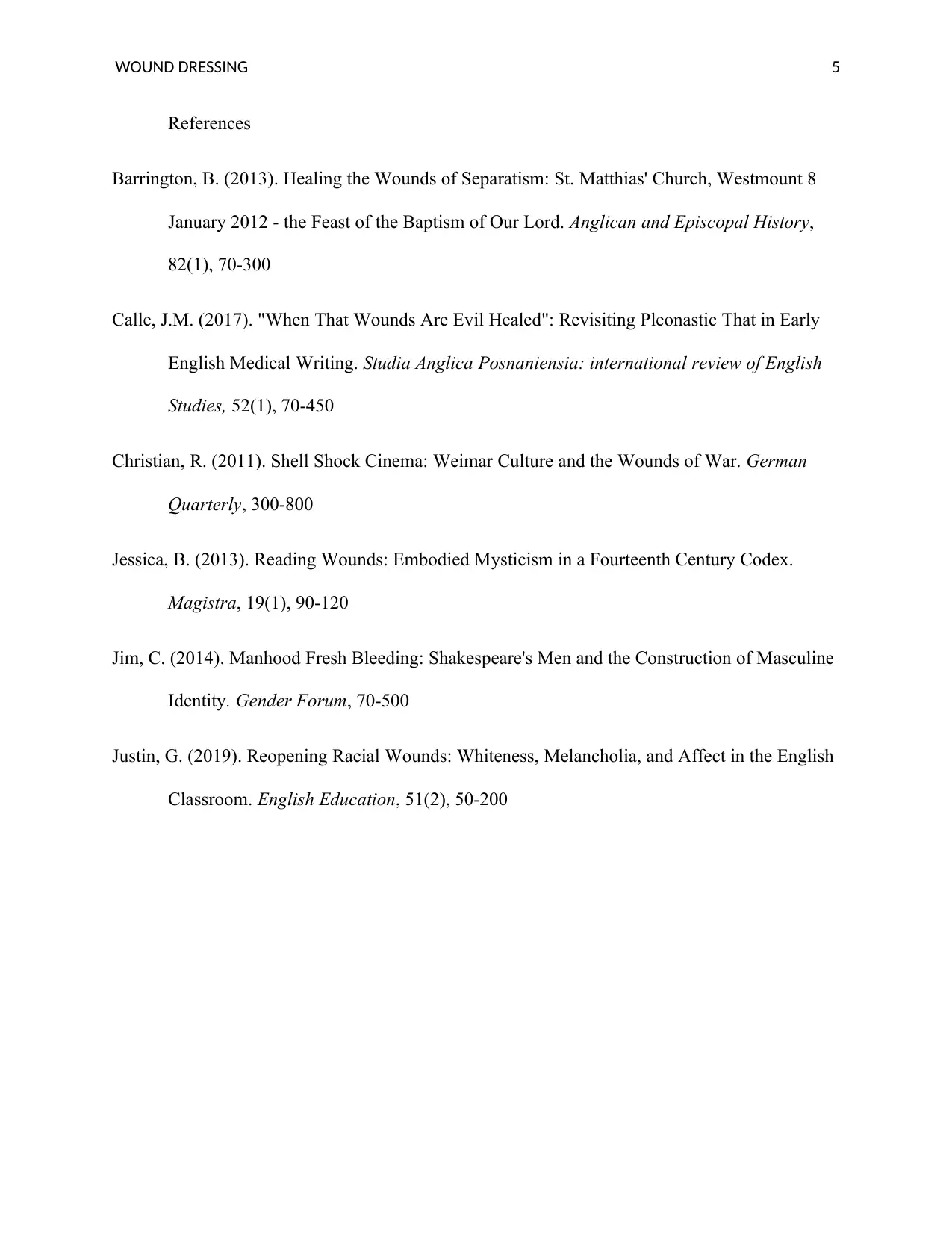
WOUND DRESSING 5
References
Barrington, B. (2013). Healing the Wounds of Separatism: St. Matthias' Church, Westmount 8
January 2012 - the Feast of the Baptism of Our Lord. Anglican and Episcopal History,
82(1), 70-300
Calle, J.M. (2017). "When That Wounds Are Evil Healed": Revisiting Pleonastic That in Early
English Medical Writing. Studia Anglica Posnaniensia: international review of English
Studies, 52(1), 70-450
Christian, R. (2011). Shell Shock Cinema: Weimar Culture and the Wounds of War. German
Quarterly, 300-800
Jessica, B. (2013). Reading Wounds: Embodied Mysticism in a Fourteenth Century Codex.
Magistra, 19(1), 90-120
Jim, C. (2014). Manhood Fresh Bleeding: Shakespeare's Men and the Construction of Masculine
Identity. Gender Forum, 70-500
Justin, G. (2019). Reopening Racial Wounds: Whiteness, Melancholia, and Affect in the English
Classroom. English Education, 51(2), 50-200
References
Barrington, B. (2013). Healing the Wounds of Separatism: St. Matthias' Church, Westmount 8
January 2012 - the Feast of the Baptism of Our Lord. Anglican and Episcopal History,
82(1), 70-300
Calle, J.M. (2017). "When That Wounds Are Evil Healed": Revisiting Pleonastic That in Early
English Medical Writing. Studia Anglica Posnaniensia: international review of English
Studies, 52(1), 70-450
Christian, R. (2011). Shell Shock Cinema: Weimar Culture and the Wounds of War. German
Quarterly, 300-800
Jessica, B. (2013). Reading Wounds: Embodied Mysticism in a Fourteenth Century Codex.
Magistra, 19(1), 90-120
Jim, C. (2014). Manhood Fresh Bleeding: Shakespeare's Men and the Construction of Masculine
Identity. Gender Forum, 70-500
Justin, G. (2019). Reopening Racial Wounds: Whiteness, Melancholia, and Affect in the English
Classroom. English Education, 51(2), 50-200
1 out of 5
Related Documents
Your All-in-One AI-Powered Toolkit for Academic Success.
+13062052269
info@desklib.com
Available 24*7 on WhatsApp / Email
![[object Object]](/_next/static/media/star-bottom.7253800d.svg)
Unlock your academic potential
Copyright © 2020–2025 A2Z Services. All Rights Reserved. Developed and managed by ZUCOL.





